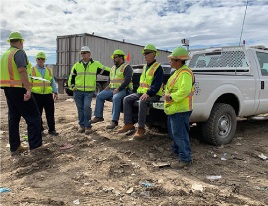CAPITAL IMPROVEMENT PROJECTS required construction of massive landfill infrastructure, including fill area and stormwater management.

At Olinda Alpha Landfill in Brea, crews spent nearly eight months building a new 2.4-acre basin, called Basin C. Not only is it the largest basin at the site, it can hold rainwater from multiple storms and allows sediment to settle faster so it can be transferred to water trucks more quickly.

At Frank R. Bowerman Landfill, crews completed Phase VIIIB-2. The project moved more than five million cubic yards of dirt, laid five-and-a-half miles of pipe, and installed more than 26 acres of liner. When at capacity, Phase VIIIB-2 will hold more than 11 million tons of trash and will generate approximately $500 million in revenue.

OCWR broke ground on Phase D at Prima Deshecha Landfill in May 2018. Phase D extends the capacity of Zone 1 by 7.5 million tons and increases its lifespan by 13.7 years at the current fill rate. Crews are on track to complete Phase D in the spring of 2019, with full operation in the summer of 2019.
"Landfills are highly engineered, highly regulated components of the California solid waste disposal system. They are not dumps. "
"Landfills are not dumps; they are highly engineered, highly regulated components of the California solid waste disposal system."
Landfills are highly engineered, highly regulated components of the California solid waste disposal system. They are not dumps. They require hundreds of regulatory inspections at various frequencies, and tracking the regulatory processes is a complex workflow. In an effort to improve efficiency, OCWR partnered with the County’s IT department to develop the Compliance Alert & Reporting System (CARS). This automated solution ensures that regulatory compliance tasks are all performed and submitted in a timely manner.
We also launched the Master Capital Expenditure Plan (MCEP) to provide digital project reports on the schedule, budget and airspace capacity related to landfill development. The program is integrated with our Disposal Reporting System and can perform “what-if” scenarios on tonnage and airspace utilization.

CAT heavy equipment simulators arrived at OCWR Landfills in 2018 as a safety training method, allowing operators to train under any weather conditions and site situations. With six 42” screens and a motion system designed to mimic vibrations and movements, the simulators offer realistic training experience without the risk of equipment damage or physical harm to staff.
In 2018, select OCWR staff at all three sites completed their Remote Pilot Airman Certification, enabling them to perform critical monitoring and surveying. Drones perform volume and airspace calculations, and capture real-time aerial photographs and topographies. This helps keep the landfill’s engineering design on track. In potentially hazardous areas, such as pop-outs or areas damaged by extreme weather conditions, drones safely perform reconnaissance without endangering human life.
OCWR’s Strategic Plan includes an initiative to develop a comprehensive approach to soil management, which our staff completed in 2018. Using complex calculations, the Landfill Soil Management Plan identifies the available onsite soil at each landfill and how much will be needed throughout the life of the landfill, and provides policy and operational recommendations to address each site’s needs.
Over the past 10 years, the Prima Deshecha Landfill received less than half of its permitted waste. To capitalize on the remaining capacity, OCWR submitted an application to revise its Solid Waste Facility Permit that would extend the closure dates of both Zone 1 and Zone 4.
As part of the application process, OCWR held two community meetings for residents living near the Prima Deshecha Landfill. Our goal was simple: educate and inform residents about the closure date revisions, answer questions and explain changes in the waste industry and how these affect the landfills.
Through a Cooperative Agreement, OCWR worked with the City of San Juan Capistrano to extend the landfill closure dates from 2019 to 2050 for Zone 1, and from 2067 to 2102 for the future Zone 4.
We launched a new initiative designed to enhance the OCWR safety culture through teamwork and ownership to ensure an effective and sustainable safety system for our people.
It also includes pursuit of Safety & Health Achievement Recognition Program (SHARP) status. This is a rigorous process offered by OSHA, the U.S. Occupational Safety and Health Administration. Attaining this standing means OCWR will have surpassed the basic safety standards and rules, and moves into a zone where our safety culture guides and permeates operations. We are well on our way to achieving SHARP certification in 2019, and continue to improve upon other safety systems based on our Injury and Illness Prevention Program and emergency response protocol.
 “We need to pay attention to the safety of our customers
“We need to pay attention to the safety of our customers - JOSE VALERIO
FEE STATION ATTENDANT SUPERVISOR,
PRIMA